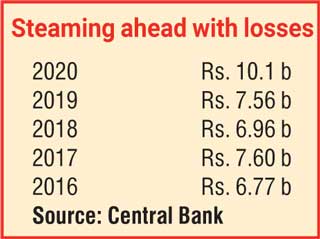Friday Dec 05, 2025
Friday Dec 05, 2025
Monday, 2 August 2021 00:29 - - {{hitsCtrl.values.hits}}

 Sri Lanka Railway’s (SLR) losses have crossed the Rs. 10 billion mark in 2020, reflecting a worsening financial position, partly aggravated by lower revenue due to COVID-induced travel restrictions apart from longstanding efficiency issues.
Sri Lanka Railway’s (SLR) losses have crossed the Rs. 10 billion mark in 2020, reflecting a worsening financial position, partly aggravated by lower revenue due to COVID-induced travel restrictions apart from longstanding efficiency issues.
In the past five years, Sri Lanka Railway (SLR) has suffered a yearly increase in losses except in 2018.
Last year SLR’s total revenue declined by 42.2% to Rs. 4.56 billion, largely driven by a 45.6% contraction in revenue generated from passenger transport. Expenditure amounted to Rs. 14.6 billion, down by 5.5% from 2019.
Thanks to an upward revision of passenger fares in October 2018, revenue in 2019 rose by 6.6% to Rs. 7.9 billon. Passenger fares account for about 81% of the total revenue of SLR. However in 2018, revenue growth was 14.4%.
The Central Bank said SLR operations in 2020 were impacted by mobility restrictions imposed to curb the spread of COVID-19.
The overall operated kilometrage and passenger kilometrage of the SLR declined notably by 28.9% and 46.6%, respectively. With the removal of the nationwide mobility restrictions from end-April 2020 onwards, rail passenger kilometrage recovered gradually, but remained below the average rail passenger kilometrage recorded in the pre-pandemic period. Operating expenditure in 2020 declined by 5.5% to Rs. 14.6 billion as against a 7.5% rise in 2019.
Although goods kilometrage recorded a significant contraction during the period from March to May 2020, the overall decline during the year was limited to 1.1% with a recovery observed in freight transportation in the latter part of the year.
The Central Bank said infrastructure development and improvement activities undertaken by the SLR to ensure efficient passenger and freight transportation in the country were disrupted by the COVID-19 pandemic. However, the SLR continued to carry out several development and enhancement activities during the period, albeit at a slower pace.
During 2020, the rehabilitation of the Maho-Omanthai railway line project continued, while double tracking of the railway lines from Polgahawela to Kurunegala and from Payagala South to Aluthgama commenced during the period.
Rehabilitation activities of railway stations continued during the year with several railway stations located in areas with tourist attractions undergoing renovation with the financial assistance of the Sri Lanka Tea Board.
With a view to enhancing the rolling stock position, the SLR procured 10 locomotives, six normal power sets, nine up-country service-related power sets, 20 float wagons and 30 oil tank wagons during 2020. Advance payments were made to purchase two air-conditioned power sets and 160 passenger coaches from India.
The project to rehabilitate 200 passenger coaches continued and 50 passenger coaches were released back into service in 2020. As an extension of this project, the Cabinet of Ministers granted approval for the rehabilitation of an additional 100 passenger carriages.
With the intention of improving the safety of railway crossings, initiatives were underway to procure 200 protected level crossing systems under the New Hungarian Credit Line.
Previously the Central Bank has maintained that SLR has the potential to improve its services as a low cost mass transportation mode for passengers and goods, and thereby reduce urban and suburban traffic congestion to a great extent.
However, improvement of the railway service is essential to provide a comfortable and efficient transport mode for the public. As at end 2019, 65% of the train fleet owned by the SLR were older than 30 years. Therefore, modernisation of the existing rolling stock as well as railway tracks is required to overcome losses in terms of productive man hours and energy utilisation.
Further, the reliability of the service is the most important factor for railway transportation to become a popular and efficient mode of transportation. According to the overall train operations statistics of the SLR, 48.4% of trains were not operated punctually and 7.5% trains had been delayed by more than one hour as per 2018 data.
Around 4.9% of the scheduled trains were cancelled during the same period. Hence, it is necessary for the SLR to identify possible reasons for delays and cancellations, and formulate solutions to improve the efficiency of service delivery. Further, establishing parking facilities near railway stations to encourage the park and ride concept must be explored as a solution for congestion in urban areas, the Central Bank noted.